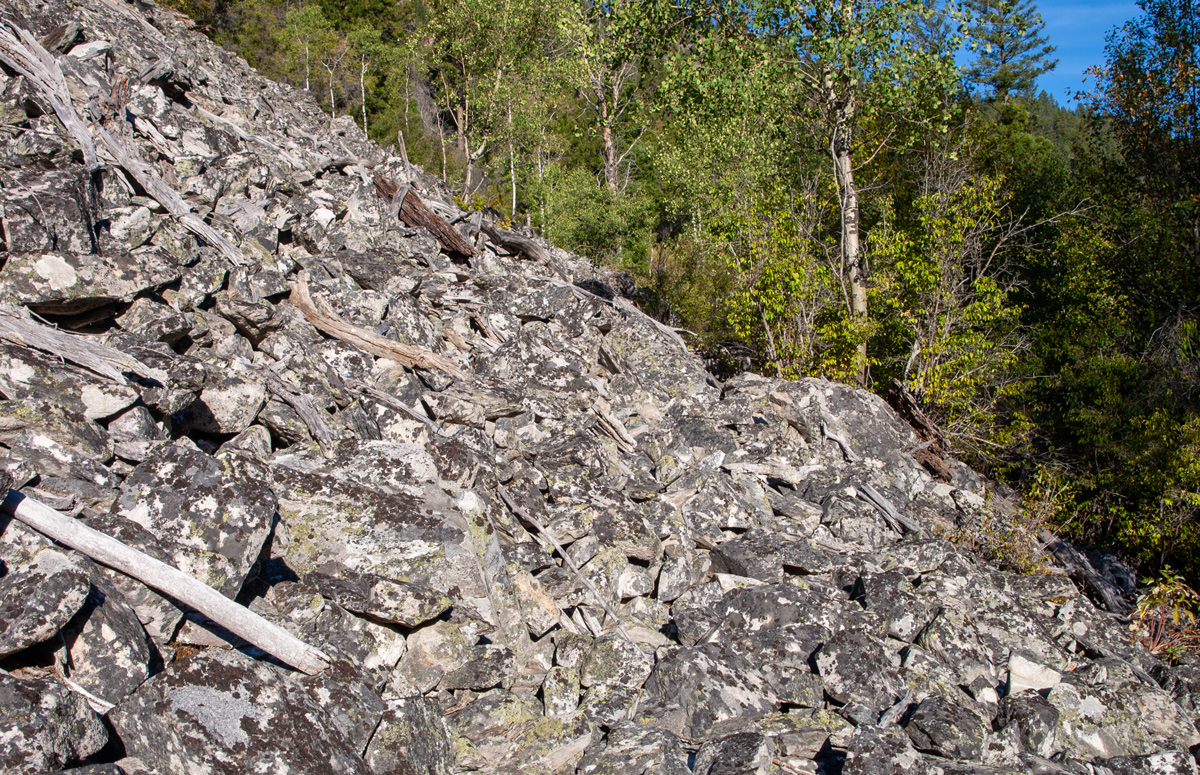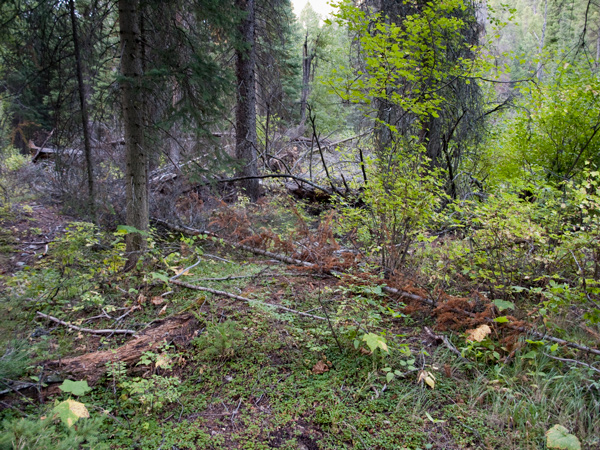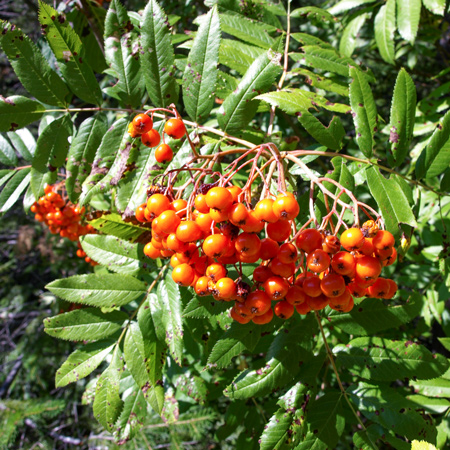When the Corps leaves the established Indian road—against the advice of guide Toby—and instead continues up the North Fork Salmon River, they must cut their own trail. They pass through thick brush and a “dismal swamp” and the horses stumble and fall crossing rocky hillsides. Hunting is poor, and Lewis collects a specimen of Cascade mountain-ash.
Horses Slip and Fall
by Yellowstone Public Radio[1]Originally aired weekdays by Yellowstone Public Radio during the Bicentennial observance of 2003-2006. Narrated by Hal Hansen. Scripts by Whit Hansen and Ed Jacobson. Produced by Leni Holliman. © … Continue reading
Dangerous Hills
Talus Slope, North Fork Salmon River
© 9 September 2009, by Kristopher K. Townsend. Permission to use granted under the Creative Commons Attribution-Share Alike 4.0 International license.
Above: a faint trail crosses the talus slope. These wobbly rocks still make for precarious footing just as described by William Clark.
we were obliged to Cut a road, over rockey hill Sides where our horss were in pitial danger of Slipping to Ther certain distruction & up & Down Steep hills, where Several horses fell, Some turned over, and others Sliped down Steep hill Sides, one horse Crippeled & 2 gave out. with the greatest dificuelty risque &c. we made five miles
—William Clark
Leaving the Indian Road
at 8 miles left the roade on which we were pursuing and which leads over to the Missouri; and proceeded up a West fork without a roade
—William Clark
Brush and Fallen Trees
North Fork Salmon River
© 9 September 2009, by Kristopher K. Townsend. Permission to use granted under the Creative Commons Attribution-Share Alike 4.0 International license.
The river is to the right of the photo and the talus slope in the previous photo is to the left.
Dismal Swamp
we proceeded on up the creek passed through verry bad thickets where we were oblidged to cut a road for our horses to pass through . . . . Some places muddy. we call this place dismal Swamp.
—John Ordway
Poor Hunting
nothing killed this day by the hunters only a fiew fessents. no game of any kind to be Seen in these mountains.
—John Ordway
Cascade Mountain-ash
Sorbus scopulina
Fish Creek below Hungery Creek, Idaho, 3 September 2008. © by Kristopher K. Townsend. Permission to use granted under the Creative Commons Attribution-Share Alike 4.0 International license.
Cascade Mountain-ash Specimen
No 24. found the day of Sepbr. 1805.
a small growth only rising to the hight of 15 feet moist situations it seems to prefer. it is a hansome growth.—
—Meriwether Lewis[2]Sorbus scopulina. Moulton, ed. Herbarium, specimen 162.
Weather Diary
State of the Thermometer at rise
Weather at rise
Wind at rise
State of the Thermometer at 4 P.M. Weather at 4 P.M. Wind at 4 P.M. 36 [above 0] cloudy after rain N E 60 [above 0] cloudy after rain and hail N E Service berries dried on the bushes abundant and very fine. black colour.
—Meriwether Lewis[3]To assist the reader, the editor of this web page has omitted the date column and spelled out some abbreviations.
Notes
| ↑1 | Originally aired weekdays by Yellowstone Public Radio during the Bicentennial observance of 2003-2006. Narrated by Hal Hansen. Scripts by Whit Hansen and Ed Jacobson. Produced by Leni Holliman. © 2003 by Yellowstone Public Radio. |
|---|---|
| ↑2 | Sorbus scopulina. Moulton, ed. Herbarium, specimen 162. |
| ↑3 | To assist the reader, the editor of this web page has omitted the date column and spelled out some abbreviations. |
Experience the Lewis and Clark Trail
The Lewis and Clark Trail Experience—our sister site at lewisandclark.travel—connects the world to people and places on the Lewis and Clark Trail.
Discover More
- The Lewis and Clark Expedition: Day by Day by Gary E. Moulton (University of Nebraska Press, 2018). The story in prose, 14 May 1804–23 September 1806.
- The Lewis and Clark Journals: An American Epic of Discovery (abridged) by Gary E. Moulton (University of Nebraska Press, 2003). Selected journal excerpts, 14 May 1804–23 September 1806.
- The Lewis and Clark Journals. by Gary E. Moulton (University of Nebraska Press, 1983–2001). The complete story in 13 volumes.




